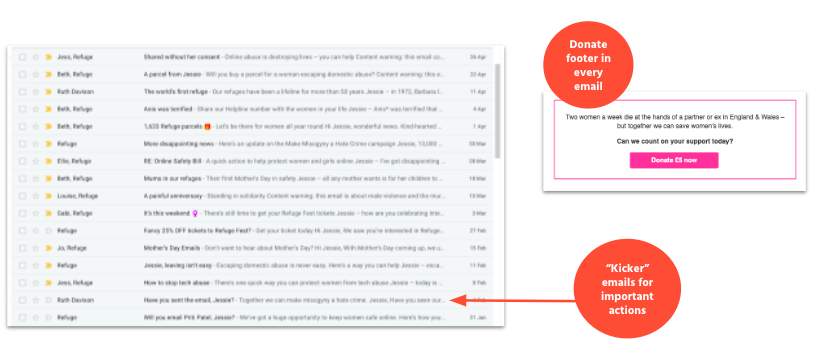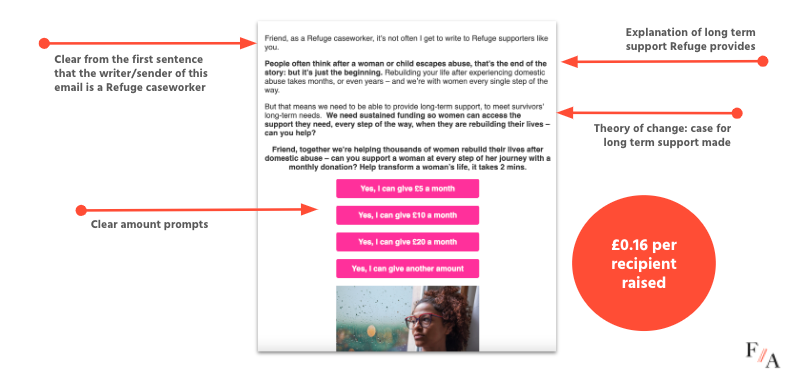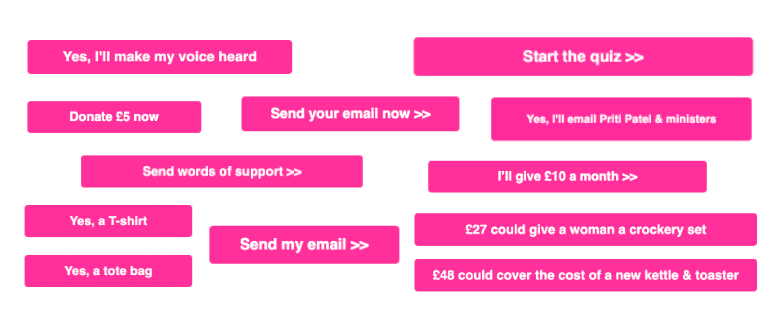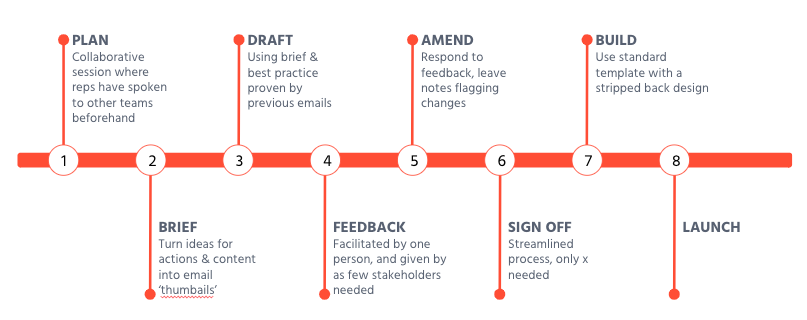Year after year, email proves to be the digital fundraising channel with the best ROI. But if your organisation is still to be convinced, or you need advice on where to get started – read on!
In our May webinar (watch the recording), Refuge’s Beth Mullins (Individual Giving Manager) and Forward Action’s Jessie Hayes (Digital Strategy Manager) talked through their top tips on how to plan, write and send emails that engage supporters for 52 weeks of the year!
What can email do for you (and what did it do for Refuge)?
When Refuge started out on their email journey, they had a list of just 7,000 supporters – many of whom hadn’t received an email for over a year.
But fast forward two years and together we’d grown this list to over 116,000 supporters, all receiving weekly emails with clear, impactful ways to help Refuge’s mission.
Having such a strong community has been hugely beneficial to Refuge. A strong email programme can help to:
- Drive real world change – In one year of emails, Refuge saw over 43k supporter actions taken and a further 7,381 ‘high-bar’ actions, such as joining campaign webinars or emailing MPs. This public pressure has added valuable weight to Refuge’s campaigning work and has led to hugely important changes to the law to protect women.
- Deepen support for your cause – Email has always been a holistic extension of Refuge’s brand and cause, reaching supporters with breaking news and the most important action for them to take at any time. Email actions such as asking supporters to send words of support to those using their refuges on Mother’s Day, has helped bring supporters closer to the cause in a meaningful and authentic way.
- Raise valuable funds – Of course having a supporter base who are truly engaged in your mission, and active in bringing that change about, means they are more likely to support your cause financially too. Refuge’s email programme brought in over £170,000 in the first year alone!
Ok you’re convinced, but where do you start?
If you can see all the benefits of a strong email programme, but just don’t know where to start, luckily Beth and Jessie have some handy top tips to get you up and running!
1. Build your list and be consistent
The first lesson Beth and Jessie are keen to stress is to make sure you send emails regularly. This means aiming for at least once a week, and not being afraid to send more when you have breaking news or important ways your supporters can help.
If supporters have given you their email, it’s because they want to hear from you – and they want to know how they can help your cause. As long as your emails are varied and engaging (more on that below!), you really don’t need to worry about sending too many emails.
Refuge also invested in growing their supporter list and have seen the benefits of a much bigger email list over the past year. Put simply, more people receiving your emails means more people taking all the valuable actions you send!

2. Work with the content you have…
Finding enough content to send an email a week might feel daunting at first. But given all the amazing work done across the charity sector, the chances are your organisation already has plenty of interesting voices and different perspectives that supporters would love to know about!
For Refuge, this meant creating emails from their CEO Ruth Davison, a Refuge Helpline worker, a Refuge caseworker and a woman that they’d supported. Beth advises having lots of conversations internally to help find these different perspectives, and creating a system that allows you to build up a bank of case studies and powerful quotes that can be used at a moment’s notice.

3. Be creative with your content and your asks
With a little creativity, your bank of powerful stories could be used in a huge variety of ways! Turning your case studies into an array of content and actions that supporters can take will keep your emails interesting and engaging.
For example, using flexible systems such as Typeform means you could turn powerful stats into an engaging quiz, follow up a personal story by asking supporters to send a message of support, or respond to breaking news by getting people to email MPs or ministers. Another lesson from Refuge was trialling topical donate asks – for example asking supporters to cover the cost of a school uniform as school’s returned in September.

4. Simplify the process
Another big reason for the success of Refuge’s email programme has been developing a clear and simple process for planning, writing and building their emails.
Over time, this process has evolved to include a more joined-up process with policy and media colleagues, ensuring supporters are in the know about upcoming stories or reports, clear sign-off responsibilities and feedback mechanisms, and ready-made templates to simplify builds. Refuge also avoid unnecessary segmentation, making sure that all supporters receive a wide variety of actions they can take to help, rather than assuming how individuals want to get involved.

5. Measure carefully
The final lesson is to carefully capture and analyse as much information as you can from your emails. This includes things such as open, click and action rates – with as much detail as possible.
Can you track exactly how many actions were taken as the result of your email? Can you tell which button most people clicked to get there? All of these things can help you test, analyse and refine your emails, to make sure you get the most out of every send and learn what works for your audience.
Another top tip Jessie offers is measuring income per recipient, rather than total income generated, particularly as you scale up. This will make sure you can compare the effectiveness of your fundraising emails as your list size grows.
We hope you’ve enjoyed our webinar run down. Want to join our next webinar? Get our emails.
Last, but definitely not least, we were asked lots of brilliant questions during our May webinar. Unfortunately there wasn’t time to answer them all, so here is a quick set of answers for some of the questions asked.
Q. How did you grow your email list in the first place?
At Refuge we benefited partly from some good press coverage during the Covid restrictions and the impact this was having on our work, meaning we saw some organic growth.
But the main growth has come through paid acquisition using a handraiser model: finding people who share our values through paid social media ads and encouraging them to sign a ‘handraiser’ – a bit like a petition to show they agree with our cause. This gives them the option to opt-in to future emails and means we know people joining our list share our values and support our cause.
You can read more about Refuge’s work with Forward Action here.
Q. Do you get internal pushback on sending so many emails?
I have a lot of conversations internally to help people understand the value of the email programme and make sure internal stakeholders have all the information they need so that they’re brought in.
But I would say a good starting point would be a pilot – that way you can start more gradually and build up the evidence to show people that it works, and that through a variety of supporter actions regular emails will benefit the whole organisation.
Q. How do you avoid bombarding supporters with too many fundraising asks?
I do pushback on some things internally, and it’s important our emails stay supporter focused – so emails shouldn’t just be an update because we want to tell people something, it should have a really clear way that they can get involved.
The key thing is to have lots of variety in your emails – this ensures we don’t send back to back fundraising emails for example, as there are always other actions in between. We also have variety within fundraising asks; for example buying merch, funding specific items, or becoming a regular giver.
Q. Could you share any details about your welcome journey? Do you send more than one a week during this time?
New supporters to Refuge, who’ve opted in to emails will go through our automated welcome series. This is a collection of emails with a variety of CTAs, introducing the supporter to our specialist services. They normally receive 1-2 emails a week, but this varies as sometimes we test the frequency to see if performance improves.
Q. Do you send your weekly email on the same day every week? And do you try to ensure service users aren’t on the list or not worry about that?
We don’t have a specific time or day for when we send our emails. On occasion our emails are in response to a media piece etc. so we like to update our supporters as soon as we can.
We don’t know if a supporter is a service user or not, unless they tell us. With 1 in 4 women experiencing domestic abuse in her lifetime, we are aware that our list is made up of survivors and last year we sent out a survey which highlighted we have a community of survivors who fundraise and support our work. With this in mind, when sharing a case study we add a content warning at the top of the email, but otherwise we don’t worry about them being on the list because the emails we write are respectful about service users.
Q. Do you have any advice on how to help with planning – which system or programs do you use to help document and plan?
At present the Individual Giving team use Tasks in Teams to plan, and use Excel for our rolling schedule and data brief. We also have a dedicated ‘Feedback’ channel on Teams where all public facing content is shared for signed-off. For planning sessions with Forward Action, we use Mural to gather ideas and then the proposed emails are formatted into into a Google Slide deck which we then add comments to etc.
Q. What size team does Refuge have working on their email programme? Do you have any advice for a really small team, without much resource?
The Individual Giving team manages the email programme and we’re currently a team of two. To ensure we’re on top of the schedule; we plan emails in batches, have briefing docs in place and have monthly calls to update relevant teams (data and supporter care) who support the activity. I also attend weekly campaigns calls to ensure our team is up-to-date on Refuge’s policy work.
If you don’t have the resource to find new content for the emails, you could see if there’s any content from other teams which could be repurposed such as statistics and case studies from the Annual Report. Also, keeping an eye on your charity’s social media accounts can help with updates and topics to share with your list.
Q. How do you approach testing within your email programme?
Every email we send has some form of test, this is so we can optimise the performance. We often have a priority test list to refer back to when planning, which has been created with our goals in mind. When planning the emails we decide which tests we would like to implement that month, and then we match test ideas to email content. For example, image vs no image is one we often use for a merchandise ask email.

